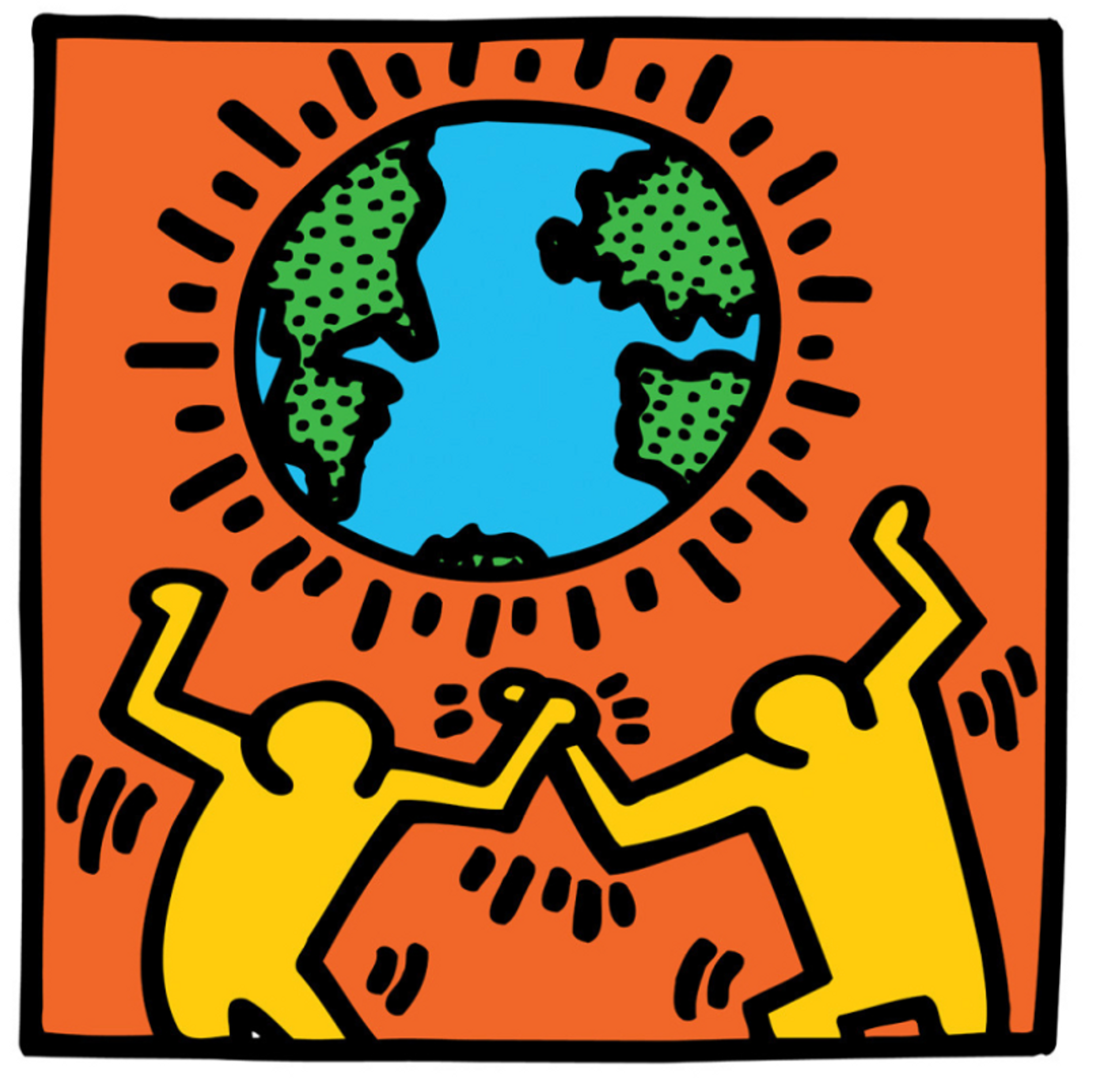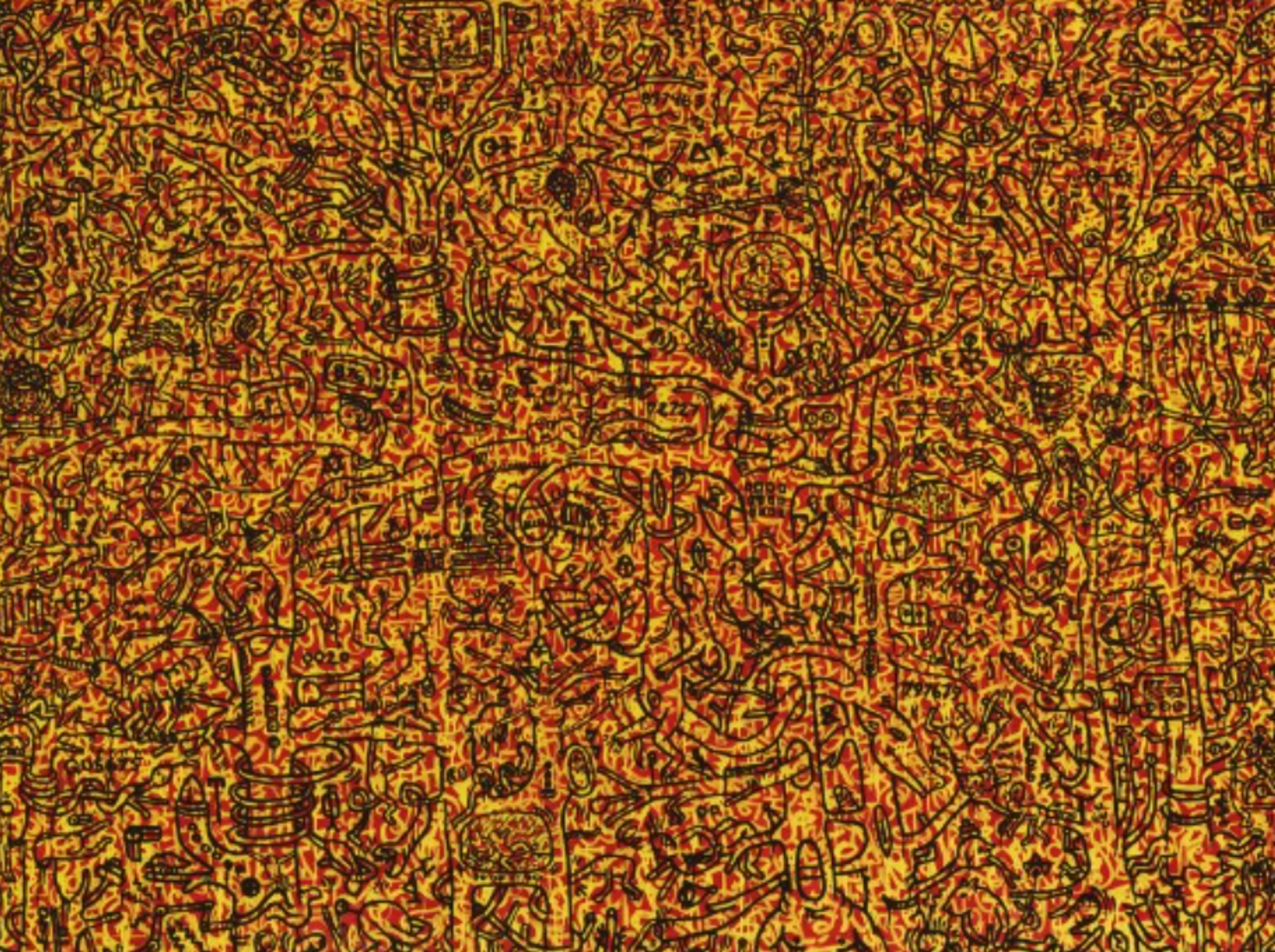 Best Buddies © Keith Haring 1990
Best Buddies © Keith Haring 1990
Interested in buying or selling
Keith Haring?

Keith Haring
250 works
Legendary pop-inspired artist, Keith Haring used his vibrant, cartoon-style art to promote human rights, social justice and equality.
How did Keith Haring die? Where was he born? Here are some facts about the artist-cum-activist:
A is for Andy Warhol
Haring met Andy Warhol in 1984, and immediately found common ground in their mutual fascination with American consumerism and the cult of pop. Andy Mouse 3, from the Andy Mouse series signed by both Haring and Warhol, pictures Warhol in the centre of a dollar bill in a Mickey Mouse costume. Through their collaboration, we see a shared interest in the relationship between art and commercialism in the modern era.
B is for Berlin Wall
In 1986, Haring painted a mural on the Berlin Wall at the request of the Checkpoint Charlie Museum. Painted on one of the most noticeable areas on the border crossing between East and West Berlin, the mural was painted in the colours of the German flag: red, black, and yellow. The horizontal figure appealed to passers by as a plea for unity between the Federal Republic of Germany West and the German Democratic Republic East.
C is for Club 57
Located in New York’s East Village, Club 57 was the underground nightclub for creatives and imaginaries. The countercultural venue was the regular haunt of Jean-Michel Basquiat, Kenny Scharf, and Haring. More than a place to party on a Friday Night, Club 57 was a hub for New York creatives, regularly staging performances, readings, and film-screenings.
D is for Dogs
The Barking Dog is a symbol that recurs throughout Haring’s work, and something he developed in his subway drawings of the early 1980s. The trademark graphic dog, made of a series of simple straight lines, is recognised as a representation of aggression towards political power.
E is for Earth
Always a strong believer in cohesion and equality, Haring’s Untitled (World) prints became a symbol of a united world. The two figures beneath the globe hold hands in celebration, showing Haring’s optimism for a future of peace on Earth.
 Untitled (world) © Keith Haring 1985
Untitled (world) © Keith Haring 1985F is for Fertility
Haring’s Fertility Suite series (1983) symbolised the constant and menacing threat of the HIV/AIDS epidemic in Sub-Saharan Africa. Despite his distinctive bright palette and joyful-looking figures, the prints have an ambiguous and macabre undertone.
G is for Graffiti
Haring began his artistic career amidst the New York graffiti scene. By developing his signature outlined figures and vibrant colouring on the streets and subways of the city, Haring made his style instantly recognisable to the public. From its inception, Haring’s approach was always about bringing art to the people, and for the people.
H is for HIV/AIDs Epidemic
Haring was diagnosed with AIDS in 1988, and died from complications of the virus two years later in 1990. However, throughout the AIDS crisis during the 1980s and during his own time suffering with the virus, Haring used his art to create positive symbols that would destigmatise HIV and AIDS. As one 1989 print stated, ‘IGNORANCE = FEAR, SILENCE = DEATH’.
I is for 'I'm not Perfect'
Grace Jones’ music video for her classic “I’m not Perfect” featured the art of both Haring and Andy Warhol. During the video, Jones wears a colossal 60ft dress that Haring doodled his characteristic figures all over.
J is for Jazz
This print was originally designed as an advertisement for the Montreux Jazz Festival in Switzerland. The coiled figure twists about the print, signalling the irrepressible impulse to boogie at the festival.
K is for Keith Haring Foundation
Established by Haring himself in 1989, the foundation lives on today in his legacy and works to provide for those affected by HIV and AIDS. The charity makes grants to non-profit groups that help provide education, prevention and care related to the virus. Haring himself staged art workshops, and produced work to support healthcare centres and communities across the USA.
L is for Love Heart
The red-filled love heart is a motif that repeats itself in Haring’s oeuvre. It is a universal symbol of love, something Haring championed for all. His genderless figures, which often hold up the love heart, show that love is something that should be granted to all regardless of gender, class, sexual orientation or race.
M is for Madonna
Pop music icon Madonna was one of Haring’s best friends. When she invited Haring to her wedding in 1985, Haring famously brought Andy Warhol as his plus-one. Throughout the 1980s she frequently wore Haring’s designs in her music videos and on stage. Madonna has continued to pay homage to her late friend; in 2018 on World AIDS Day she wrote on Instagram: ‘With My Good Friend Keith Haring. He was a big AIDS activist when everyone was calling it GAY cancer’.
N is for New York
Like so many of his star-studded contemporaries, Haring found a stimulating and welcoming home in New York. Haring moved to the city in 1978 to study at the School of Visual Arts, and quickly found himself embedded in the thriving alternative art scene. Here, Haring created some of his most celebrated murals and subway drawings, making his mark on the city unforgettable.
O is for Outlines
Haring is best known for his Pop Art-inspired prints with vibrant block colours and simple black outlines. His unfussy outlined characters fill rectangular frames, like snapshots or scenes from a comic strip. Even though his figures are faceless, they embody Haring’s championing of individuals with shared goals, ideas and needs.
P is for Pop Shop
To bring his work to an ever-wider audience, Haring opened the Pop Shop in 1986 at 292 Lafayette Street in Soho, Manhattan. The Pop Shop was not only a space for Haring to exhibit his work, but a boutique where he sold T-shirts and pins printed with his imagery. Like his universally understandable imagery, Pop Shop was emblematic of Haring’s desire to make art more accessible for all.
Q is for Queer
Haring was unique in his outward expression of his sexuality in both his artwork and the public eye. By making homosexuality a prime focus of his work, Haring worked to dispel all negativity surrounding queerness and celebrate non-conformity when it came to sexual orientation and gender.
R is for Rainforest
Described by Sotheby’s as Haring’s ‘last great masterpiece’, The Last Rainforest was painted just one year before his death in 1990. The painting is unlike Haring’s signature poster-style works, as his outlined figures are overwhelmingly drawn across a Jackson Pollock-style background. This painting was to be Haring’s last socio-political warning: a warning of the dangers of the AIDS crisis and also of nuclear technology.
 The Last Rainforest © Keith Haring 1989
The Last Rainforest © Keith Haring 1989S is for South Africa
Always a staunch advocate of human rights and equality, it is no surprise that Haring used his art to promote the end of apartheid in South Africa. His Free South Africa series was distributed across NYC in 1986, and envisioned a future when the black population of South Africa could literally stamp out inequality.
T is for Tony Shafrazi
Haring was represented by Tony Shafrazi, American art dealer and owner of the Shafrazi Art Gallery in New York. At the gallery, Haring staged his first one-man show in 1982, which was a resounding success.
U is for Upbringing
Raised in Kutztown, Pennsylvania, Haring developed his flare for drawing at an early age under the guidance of his father, Allen Haring. Allen was also a keen cartoonist, and encouraged his son to create his own characters and stories: something that translated into his successful oeuvre as an adult.
V is for the Valley
The Valley series was created in 1989 in collaboration with the beat poet William S. Burroughs. The etchings signal a shift in Haring’s visual language towards the end of his life, laden with a sense of violence and danger.
W is for Walt Disney
Haring and his father Allen were both fascinated by the cartoons produced by Walt Disney. Mickey Mouse was one of the first characters Haring learnt to draw as a child, and continued to influence his cartoonish figures.
X is for Keith Haring (X) Collaborations
Haring continues to be a prominent presence in commercial culture today. His designs have been used in multiple collaborations with brands like Dr. Martens, Uinqlo and Coach to name a few.
Y is for Yoko Ono
Ono was yet another of Haring’s famous friends. The pair partied together in the ‘80s, and shared a desire to embrace the avant-garde in both life and art.
Z is for Zodiac
Born 4th May 1958, Keith Haring is a Taurus. The earth sign is known for having a strong desire for extravagance while being reliable and down-to-earth, something Haring definitely embodied in his spirited lifestyle and art.
Browse our Keith Haring prints for sale or get a valuation here.













